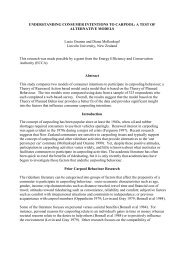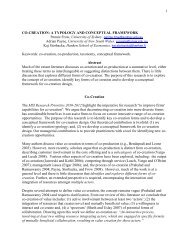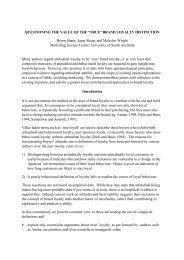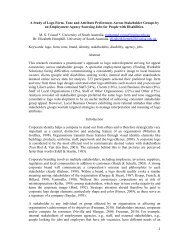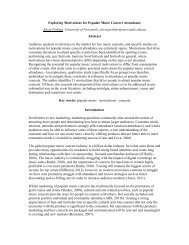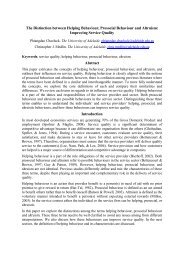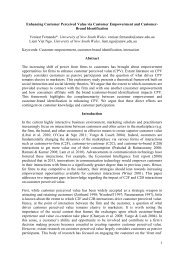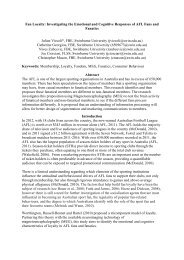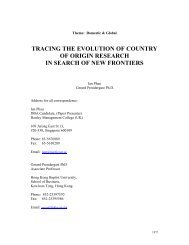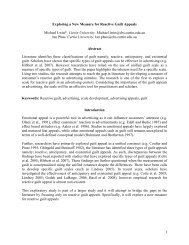Key Determinants of Successful Marketing Strategy ... - ANZMAC
Key Determinants of Successful Marketing Strategy ... - ANZMAC
Key Determinants of Successful Marketing Strategy ... - ANZMAC
You also want an ePaper? Increase the reach of your titles
YUMPU automatically turns print PDFs into web optimized ePapers that Google loves.
<strong>Key</strong> <strong>Determinants</strong> <strong>of</strong> <strong>Successful</strong> <strong>Marketing</strong> <strong>Strategy</strong> Implementation<br />
Katrina Wilson and Su Mon Wong<br />
Queensland University <strong>of</strong> Technology<br />
Track 16 Strategic <strong>Marketing</strong> Issues<br />
<strong>Key</strong>words: <strong>Marketing</strong> <strong>Strategy</strong>, Implementation, <strong>Determinants</strong> <strong>of</strong> Success, Australia,<br />
Empirical.<br />
Abstract<br />
Success in the marketplace requires that firms effectively execute their planned marketing<br />
strategies. Although this is openly acknowledged in both the academic and practitioner<br />
literature, implementation remains an under-researched area. This research aims to investigate<br />
the important variables that determine the success <strong>of</strong> a marketing strategy implementation<br />
effort within the Australian business context. Based on a review <strong>of</strong> literature, a model for<br />
implementation success was developed and tested amongst marketing managers from an array<br />
<strong>of</strong> different organisations. The implications <strong>of</strong> the results for marketing theory and practice<br />
are then discussed.<br />
Introduction<br />
While increasing numbers <strong>of</strong> marketing practitioners are concluding that one <strong>of</strong> the key routes<br />
to improved business performance is better implementation, it is also believed that<br />
implementation is one <strong>of</strong> the more difficult challenges facing today’s managers (Bonoma<br />
1985; Noble 1999; Sashital 1993). Despite this belief, surprisingly little academic research in<br />
marketing has attempted to address this critical issue (Noble and Mokwa, 1999; Sashital,<br />
1993).<br />
A variety <strong>of</strong> marketing literature has called for increased study <strong>of</strong> the marketing strategy<br />
implementation process (Bonoma, 1985; Noble, 1999; Noble and Mokwa, 1999; Sashittal,<br />
1993). This literature contends that the omission <strong>of</strong> work on the area <strong>of</strong> implementation in<br />
marketing is quite problematic given that strategy failures are <strong>of</strong>ten attributed to issues <strong>of</strong><br />
poor implementation. While there has been some attempt in the marketing literature to<br />
remedy this neglect (eg. Cespedes and Peircy, 1996; Piercy, 1998), the majority <strong>of</strong> studies<br />
have been <strong>of</strong> a normative nature. Furthermore, a review <strong>of</strong> literature reveals that there has<br />
been no exploration <strong>of</strong> the key determinants <strong>of</strong> successful marketing strategy implementation<br />
in Australian corporations. The theoretical foundation <strong>of</strong> this research area therefore needs<br />
further development to gain a deeper understanding <strong>of</strong> the key factors that contribute to the<br />
success <strong>of</strong> the marketer’s implementation effort. Accordingly, this research aims to enhance<br />
the understanding <strong>of</strong> marketing strategy implementation by investigating an integrated<br />
framework <strong>of</strong> factors that could determine marketing strategy implementation success within<br />
the Australian business context.<br />
Literature Review<br />
A key problem in marketing strategy implementation research is that it is fragmented among<br />
several fields <strong>of</strong> organisation and management studies (Hrebinak and Joyce, 1984).<br />
Furthermore, even when implementation is accepted as a problem, the marketing literature<br />
still lacks the conceptual framework or analytical tools with which to address the issues<br />
raised.<br />
2395
Against this backdrop, the key contribution <strong>of</strong> this article is the development and testing <strong>of</strong> an<br />
Australian model <strong>of</strong> marketing strategy implementation success. Based on a range <strong>of</strong><br />
literature, and more specifically, the seminal work <strong>of</strong> American researchers, Noble and<br />
Mokwa (1999), a framework was created. Three groups <strong>of</strong> variables emerged as important: 1)<br />
factors related to the nature <strong>of</strong> the strategy being implemented; 2) dimensions <strong>of</strong> commitment;<br />
and 3) implementation-related outcomes.<br />
Implementation-related outcomes: Role performance relates to the degree to which a<br />
manager achieves the goals and objectives <strong>of</strong> their role and facilitates implementation success.<br />
Previous research suggests that managers viewed the performance <strong>of</strong> their implementation<br />
roles as critical to implementation success (Noble and Mokwa, 1999).<br />
Hypothesis 1: The role performance <strong>of</strong> managers with implementation responsibilities will be<br />
related positively to the success <strong>of</strong> the implementation effort.<br />
Commitment variables: Based on a review <strong>of</strong> literature, three dimensions <strong>of</strong> commitment<br />
emerged as directly affecting outcomes. Organisational commitment, as an antecedent <strong>of</strong> job<br />
performance and satisfaction, has been the focus <strong>of</strong> organisational behaviour studies for many<br />
years (Darden, Hampton and Howell, 1989). Past research reveals a link between high<br />
commitment and high levels <strong>of</strong> satisfaction and the willingness to exert effort on behalf <strong>of</strong> an<br />
organisation. A second aspect <strong>of</strong> commitment, strategy commitment, refers to the extent to<br />
which a manager comprehends and supports the objectives <strong>of</strong> a marketing strategy. Middle<br />
managers with low or negative commitment to the strategies formulated by senior<br />
management can create significant obstacles to effective implementation (Guth and<br />
MacMillan, 1986). Consequently, the ability to manage the processes needed to secure<br />
positive and pervasive commitment to strategy on the part <strong>of</strong> middle management is seen to<br />
be critical to implementation success. Finally, the third dimension <strong>of</strong> commitment, role<br />
commitment, is defined as ‘the extent to which a manager is determined to perform their<br />
individual implementation responsibilities well’. The significance <strong>of</strong> this factor relates to an<br />
ability to foster career commitment among managers if they are to perform their roles<br />
successfully (Darden, Hampton and Howell, 1989). Noble and Mokwa (1999) found a strong<br />
link between role commitment and role performance.<br />
Hypothesis 2: Higher levels <strong>of</strong> organisational commitment will be associated with better role<br />
performance by managers with implementation responsibilities.<br />
Hypothesis 3: Higher levels <strong>of</strong> strategy commitment will be associated with better role<br />
performance by managers with implementation responsibilities.<br />
Hypothesis 4: Higher levels <strong>of</strong> role commitment will be associated with better role<br />
performance by managers with implementation responsibilities.<br />
<strong>Strategy</strong> variables: Various aspects <strong>of</strong> strategy appear to influence the extent to which<br />
managers are committed to its implementation. Fit with vision refers to the extent to which<br />
the marketing strategy is perceived to fit within the broader strategic direction <strong>of</strong> the<br />
company. Past studies suggest that fit influences a manager’s commitment to ensure that a<br />
strategy is successfully implemented (Noble 1999b; Noble and Mokwa, 1999). The perceived<br />
importance <strong>of</strong> a strategy has also been demonstrated to influence a manager’s commitment to<br />
its implementation. <strong>Marketing</strong> strategies that represent major opportunities for a firm, require<br />
significant internal change, or will have a significant influence on the organisation’s future,<br />
appear to instill higher levels <strong>of</strong> commitment among managers with implementation<br />
responsibilities (Noble and Mokwa, 1999). Scope refers to the extent to which a strategy<br />
involves a range <strong>of</strong> managers and functions within the organisation. Implementation efforts<br />
that are wide in scope are expected to result in a stronger support network for the individual<br />
2396
manager, leading to greater managerial commitment. Championing has been identified as a<br />
means <strong>of</strong> generating support for a strategy within a firm (Cespedes and Piercy, 1996; Noble<br />
1999a; Nutt, 1983). Acting as a driving force within the organisation, it seems likely that a<br />
strategy champion will instill a higher level <strong>of</strong> strategy commitment.<br />
Hypothesis 5: For a strategy being implemented, higher levels <strong>of</strong> perceived fit with an overall<br />
strategic vision will be associated with higher levels <strong>of</strong> strategy commitment among managers<br />
with implementation responsibilities.<br />
Hypothesis 6: <strong>Marketing</strong> strategies that are perceived as having a higher level <strong>of</strong> importance<br />
will be associated with a higher level <strong>of</strong> strategy commitment among managers with<br />
implementation responsibilities.<br />
Hypothesis 7: <strong>Marketing</strong> strategies that are broader in scope will be associated with higher<br />
levels <strong>of</strong> strategy commitment among managers with implementation responsibilities.<br />
Hypothesis 8: Higher levels <strong>of</strong> perceived championing will be associated with higher levels <strong>of</strong><br />
strategy commitment among managers with implementation responsibilities.<br />
Obtaining the support <strong>of</strong> senior management has been recognised in a vast array <strong>of</strong><br />
organisational and management fields as an essential component in successful strategy<br />
implementation efforts (Robertson and Gatignon 1986; Whitney and Smith 1983). Similarly,<br />
in the marketing strategy implementation context, it is expected that a higher level <strong>of</strong><br />
perceived senior management support will be associated with higher levels <strong>of</strong> strategy<br />
commitment among managers with implementation responsibilities (Noble and Mokwa,<br />
1999) Another factor recognised in the literature for its role in facilitating successful<br />
implementation, is organisational buy-in to a strategy, or the achievement <strong>of</strong> broad company<br />
support (Noble, 1999). The importance <strong>of</strong> this factor stems from the contention that early buyin<br />
will produce higher levels <strong>of</strong> managerial understanding and commitment to strategy<br />
implementation. Finally, the commitment <strong>of</strong> organisational participants may be enhanced by<br />
managed participation in the strategy process. Participation can generate commitment to<br />
strategy implementation by encouraging empowerment, responsibility and a sense <strong>of</strong><br />
ownership (Dimitri, 1995).<br />
Figure 1 portrays the relationship among the variables as investigated in the hypotheses.<br />
Figure 1 Research framework<br />
Fit with vision<br />
Importance<br />
Scope<br />
Championing<br />
Senior Management Support<br />
Buy-in<br />
Participation<br />
<strong>Strategy</strong> Factors<br />
Dimensions <strong>of</strong><br />
Commitment<br />
Organisational<br />
Commitment<br />
<strong>Strategy</strong><br />
Commitment<br />
Role Commitment<br />
Source: developed for this research, adapted from Noble and Mokwa (1999)<br />
Individual and Organisation-Level<br />
Outcomes<br />
Role Performance Implementation<br />
Success<br />
Hypothesis 9: Higher levels <strong>of</strong> perceived senior management support will be associated with<br />
higher levels <strong>of</strong> strategy commitment among managers with implementation responsibilities.<br />
2397
Hypothesis 10: Higher levels <strong>of</strong> organisational buy-in for a given marketing strategy will be<br />
associated with higher levels <strong>of</strong> strategy commitment among managers with implementation<br />
responsibilities.<br />
Hypothesis 11: Higher levels <strong>of</strong> participation in strategy formulation and decision making<br />
processes will be associated with higher levels <strong>of</strong> strategy commitment among managers with<br />
implementation responsibilities.<br />
Methodology<br />
The nature <strong>of</strong> this research was both confirmatory (it sought to test the applicability <strong>of</strong> Noble<br />
and Mokwa’s (1999) model in the Australian business context) and exploratory (seeking to<br />
uncover any new relationships that may exist). Structural equation modeling was the primary<br />
method <strong>of</strong> analysis, used to assess the direct causal contributions <strong>of</strong> antecedent variables onto<br />
consequent variables. This was performed in two parts, which comprised <strong>of</strong> an assessment <strong>of</strong><br />
the adequacy <strong>of</strong> the overall model as well as individual path coefficients. Questionnaires were<br />
mailed to 813 marketing managers <strong>of</strong> service or manufacturing companies in Queensland,<br />
NSW or Victoria. A total <strong>of</strong> 220 questionnaires were returned, representing a response rate <strong>of</strong><br />
26%. SPSS was used to compute correlations, frequencies and scale reliabilities while AMOS<br />
was employed for structural equation modeling. Manifest variables were utilised in this<br />
analysis due to sample size restrictions, which prohibited a latent factor model.<br />
Results And Discussion<br />
The results <strong>of</strong> the analysis revealed that the overall fit <strong>of</strong> the model was not supported in the<br />
context <strong>of</strong> this research. This raised questions as to the generalisability <strong>of</strong> Noble and Mokwa’s<br />
(1999) research framework to the Australian market. Variations in the sampling procedure<br />
between this study and the study <strong>of</strong> Noble and Mokwa (which surveyed from within only two<br />
large organizations rather than a wide cross section <strong>of</strong> companies), model adaptations, and<br />
cross-cultural differences are possible causes for the weak model fit. However, other<br />
important contributions <strong>of</strong> this research were observed since most <strong>of</strong> the individual path<br />
relationships in the model were supported as hypothesised.<br />
Table 1 Path Coefficients<br />
Standardised Regression Weight Correlations Estimate Standard<br />
Error<br />
P-value<br />
Role Performance -Implementation Success 0.520 0.177 0.055 0.000<br />
Organisational Commitment - Role performance 0.351 0.020 0.052 0.727<br />
<strong>Strategy</strong> Commitment - Role Performance 0.468 0.179 0.059 0.001<br />
Role Commitment - Role Performance 0.682 0.591 0.063 0.000<br />
Vision - <strong>Strategy</strong> Commitment 0.476 0.292 0.052 0.000<br />
Importance - <strong>Strategy</strong> Commitment 0.429 0.264 0.053 0.000<br />
Scope - strategy Commitment 0.109 -0.168 0.036 0.017<br />
Championing - <strong>Strategy</strong> Commitment 0.453 0.295 0.043 0.000<br />
Senior management support - <strong>Strategy</strong> Commitment 0.298 -0.153 0.053 0.060<br />
Buy-in - <strong>Strategy</strong> Commitment 0.298 0.075 0.055 0.371<br />
Participation - <strong>Strategy</strong> commitment 0.382 0.138 0.054 0.028<br />
Senior management support - Role performance 0.368 0.160 0.039 0.003<br />
Participation - Implementation success 0.535 0.184 0.059 0.001<br />
Buy-in - Implementation Success 0.545 0.255 0.045 0.000<br />
Championing - Implementation Success 0.648 0.387 0.044 0.000<br />
The fundamental relationship between role performance and implementation success (H1)<br />
was supported, demonstrating the need for steps to be taken so that goals and objectives<br />
within a manager’s implementation role are clearly understood. Hypothesis 3, which<br />
2398
suggested a relationship between strategy commitment and role performance also received<br />
support. This implies that mangers must fully comprehend and support the goals <strong>of</strong> a strategy<br />
if role performance and successful implementation are to occur. These findings are consistent<br />
with the findings <strong>of</strong> Noble and Mokwa (1999), providing further evidence for the importance<br />
<strong>of</strong> these factors to marketing strategy implementation success.<br />
Among the strategy factors, fit with vision (H5), perceived importance <strong>of</strong> the strategy (H6),<br />
championing (H8) and participation (H11) were all related to strategy commitment. The scope<br />
variable had a significant influence on strategy commitment, but in a direction opposite to that<br />
hypothesized. This would suggest that the narrower the strategy’s scope, the greater the<br />
responsibility <strong>of</strong> the individual manager, and hence the greater their commitment to seeing it<br />
successfully implemented. However, two hypothesised paths involving strategy variables: 1)<br />
senior management support to strategy commitment (H9); and 2) buy-in to strategy<br />
commitment (H10) were not significant and were subsequently deleted from the model. These<br />
findings differed from those <strong>of</strong> Noble and Mokwa (1999). In the North American study, a<br />
relationship between buy-in and strategy commitment received support, whereas it was found<br />
not significant in this research. In contrast, the variable <strong>of</strong> championing, which was<br />
insignificant in their study, gained support in this research. Finally, the scope variable, had a<br />
significant influence on strategy commitment, was not supported in the North American<br />
study.<br />
In addition, four paths not specified a priori: buy-in to implementation success, participation<br />
to implementation success, championing to implementation success, and senior management<br />
support to role performance, proved to be important components <strong>of</strong> the causal structure and<br />
were hence added to the model.<br />
The data also supported a multidimensional view <strong>of</strong> commitment. As hypothesised, both<br />
strategy commitment (H3) and role commitment (H4) were shown to affect role performance.<br />
However, the most commonly studied dimension <strong>of</strong> commitment, that <strong>of</strong> organisational<br />
commitment (H2), demonstrated no relationship to role performance. This finding, while<br />
inconsistent with past organisational behaviour research is in line with Noble and Mokwa’s<br />
study. Hence, organisational commitment is a less critical factor in marketing strategy<br />
implementation than might be suggested by previous research.<br />
The implications <strong>of</strong> this research for marketing practitioners are numerous. Using the findings<br />
<strong>of</strong> this research, managers implementing marketing strategies will be able to better plan for<br />
and manage the implementation process, by ensuring that critical factors identified in the<br />
research are assigned the necessary importance. In particular, the research points to the need<br />
for effective internal communication to ensure that all members <strong>of</strong> the organization<br />
understand their respective roles in the implementation process and view the strategy and its<br />
implementation as a priority. Due to the significant difficulties encountered at the<br />
implementation stage <strong>of</strong> strategy development, knowledge <strong>of</strong> the key factors that affect<br />
implementation efforts should enhance business success in the future. In terms <strong>of</strong> theory<br />
building, this research has also filled a substantial gap in the body <strong>of</strong> knowledge regarding<br />
implementation <strong>of</strong> marketing strategies in Australian organisations, being the first to<br />
investigate a framework <strong>of</strong> factors that lead to implementation success.<br />
Conclusion<br />
The issue <strong>of</strong> marketing implementation has long been recognised as critical to marketing<br />
effectiveness and an area <strong>of</strong> particular weakness in many organisations. Despite this, scant<br />
attention has been paid to investigating the implementation process. This research has<br />
attempted to address this gap by investigating the key determinants <strong>of</strong> successful marketing<br />
2399
strategy implementation. Overall, these findings verify that implementation is a complex<br />
process that requires the interaction <strong>of</strong> several key factors in order for success to occur.<br />
Implementation must therefore be carefully planned by marketing managers so that all <strong>of</strong><br />
these factors are successfully managed and controlled.<br />
REFERENCES<br />
Aaker, D. (1998) Strategic Market Management, 5 th edition, USA: John Wiley and Sons, Inc.<br />
Aaker, D., Kumar, V. and Day, G. (1995) <strong>Marketing</strong> Research, 5 th edition, New York: John<br />
Wiley and Sons, Inc.<br />
Ans<strong>of</strong>f, I. (1980) ‘Strategic Issue Management’, Strategic Management Journal, vol. 1, No. 2,<br />
pp. 131-148<br />
Ans<strong>of</strong>f, I. (1984) Implanting Strategic Management, Englewood Cliffs, NJ: Prentice Hall<br />
Australian Bureau <strong>of</strong> Statistics (2000), Manufacturing Industry, Australia, URL:<br />
http://www.abs.gov.au/ausstats, 3/11/2000<br />
Bonoma, T. (1984) ‘Making Your <strong>Marketing</strong> Strategies Work’, Harvard Business Review,<br />
vol. 62, No. 2, pp. 69-76<br />
Bonoma, T. (1985) The <strong>Marketing</strong> Edge: Making Strategies Work, New York: The Free Press<br />
Bonoma, T. (1986) ‘<strong>Marketing</strong> Subversives’, Harvard Business Review, vol. 64, No. 6, pp.<br />
113-118<br />
Bonoma, T. and Crittenden, V. (1988) ‘Managing <strong>Marketing</strong> Implementation’, Sloan<br />
Management Review, vol. 29, Winter, pp. 7-14<br />
Cespedes, F. (1991) Organising and Implementing the <strong>Marketing</strong> Effort, Reading: Addison-<br />
Wesley Publishing<br />
Cespedes, F. and Piercy, N. (1996) ‘Implementing <strong>Marketing</strong> <strong>Strategy</strong>’, Journal <strong>of</strong> <strong>Marketing</strong><br />
Management, vol. 12, No. 1, pp. 135-160<br />
Darden, W., Hampton, R. and Howell, R. (1989) ‘Career Versus Organisational Commitment:<br />
Antecedents and Consequences <strong>of</strong> Retail Salespeoples’ Commitment’, Journal <strong>of</strong> Retailing,<br />
vol. 65, No. 1, pp. 80-106<br />
Day, G. and Wensley, R. (1983) ‘<strong>Marketing</strong> Theory with a Strategic Orientation’, Journal <strong>of</strong><br />
<strong>Marketing</strong>, vol. 47, No. 4, pp. 79-89<br />
Dimitri, P. (1995) ‘The core principles <strong>of</strong> participative management’, The Journal for Quality<br />
and Participation, vol. 18, No. 7, pp. 44-48<br />
Guth, W. and MacMillan, I. (1986) ‘<strong>Strategy</strong> Implementation versus Middle Management<br />
Self-Interest’, Strategic Management Journal, vol. 7, No. 4, pp. 313-337<br />
2400
Hrebiniak, L. (1990) ‘Implementing <strong>Strategy</strong>’, Chief Executive, vol. 57, April, pp. 74-77<br />
Hrebiniak, L., and Joyce, W. (1984) Implementation <strong>Strategy</strong>, New York: MacMillan<br />
Hrebiniak, L. and Snow, C. (1982) ‘Top-Management Agreement and Organisational<br />
Performance’, Human Relations, vol. 35, No. 12, pp. 1139-1158<br />
Noble, C. (1999) ‘The Eclectic Roots <strong>of</strong> <strong>Strategy</strong> Implementation Research’, Journal <strong>of</strong><br />
Business Research, vol. 45, No. 2, pp. 119-134<br />
Noble, C. (1999) ‘Building the <strong>Strategy</strong> Implementation Network’, Business Horizons, vol.<br />
42, No. 6, pp. 19 -28<br />
Noble, C. and Mokwa, M. (1999) ‘Implementing <strong>Marketing</strong> Strategies: Developing and<br />
Testing a Managerial Theory’, Journal <strong>of</strong> <strong>Marketing</strong>, vol. 63, No. 4, pp. 57-73<br />
Nutt, P. (1983) ‘Implementation Approaches for Project Planning’, Academy <strong>of</strong> Management<br />
Review, vol. 8, No. 4, pp. 600-611<br />
Piercy, N. (1998) ‘<strong>Marketing</strong> Implementation: The Implications <strong>of</strong> <strong>Marketing</strong> Paradigm<br />
Weakness for the <strong>Strategy</strong> Execution Process’, Journal <strong>of</strong> the Academy <strong>of</strong> <strong>Marketing</strong> Science,<br />
vol. 26, No. 3, pp. 222-236<br />
Robertson, T. and Gatignon, H. (1986) ‘Competitive Effects on Technology Diffusion’,<br />
Journal <strong>of</strong> <strong>Marketing</strong>, vol. 50, No. 3, pp. 1-12<br />
Sashittal, H. (1993) An Empirical Investigation <strong>of</strong> the <strong>Marketing</strong> <strong>Strategy</strong> Implementation<br />
Process, Michigan: UMI Dissertation Services<br />
Whitney, J. and Smith, R. (1983) ‘Effects <strong>of</strong> Group Cohesiveness on Attitude Polarization<br />
and the Acquisition <strong>of</strong> Knowledge in a Strategic Planning Context’, Journal <strong>of</strong> <strong>Marketing</strong><br />
Research, vol. 20, No. 2, pp. 167-176<br />
Wind, Y. and Robertson, T. (1983) ‘<strong>Marketing</strong> <strong>Strategy</strong>: New Directions for Theory and<br />
Research’, Journal <strong>of</strong> <strong>Marketing</strong>, vol. 47, No. 2, pp. 12-25<br />
Wooldridge, B. and Floyd, S. (1989) ‘Research Notes and Communications : Strategic<br />
Process Effects on Consensus,’ Strategic Management Journal, vol. 10, No. 3, pp. 295-302<br />
Wooldridge, B. and Floyd, S. (1990) ‘The <strong>Strategy</strong> Process, Middle Management<br />
Involvement, and Organisational Performance’, Strategic Management Journal, vol. 11, No.<br />
3, pp. 231-241<br />
Wooldridge, B. and Floyd, S. (1992) ‘Managing strategic consensus: the foundation <strong>of</strong><br />
effective implementation’, Academy <strong>of</strong> Management Executive, vol. 6, No. 4, pp. 27-39<br />
2401




